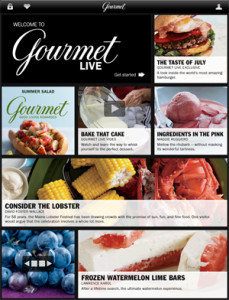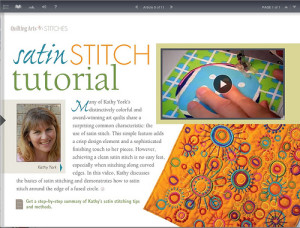 Consumers are using e-readers, smartphones, and tablets with increasing frequency. Simultaneously, magazine and newspaper publishers are rushing to keep up with declining print sales and burgeoning technology to offer digital editions on these devices. The iPad alone has changed the face of magazine publishing since its launch a few months ago.
Consumers are using e-readers, smartphones, and tablets with increasing frequency. Simultaneously, magazine and newspaper publishers are rushing to keep up with declining print sales and burgeoning technology to offer digital editions on these devices. The iPad alone has changed the face of magazine publishing since its launch a few months ago.
Numerous magazines now have accompanying iPad apps, such as Time Magazine, GQ, Vanity Fair, and more than 40 publications from Rodale. iPad has also helped IDG’s Macworld and PCWorld increase downloads of their digital editions, which have been around for years. The two publications averaged 600 monthly downloads together, but iPad versions are now generating a combined 8,000 monthly downloads. Chris Anderson of Wired predicts that iPad versions of his magazine will soon outsell its print editions.
Publishers aren’t just focusing on mobile devices for their digital editions, however. Some are developing models that can be accessed from a regular computer, such as Skiing Interactive from Bonnier Corp., which is a digital duplicate of the print version. Gourmet, which went out of print in November 2009, will be reborn this fall as Gourmet Live, an interactive HTML5 application with social features that will allow users to share content across social networks. Susan Currie Sivek writes on PBS’ Media Shift blog:
The application will use readers’ individual food and cooking interests to shape their experience. A novel component of Gourmet Live will be its ‘gameplay’ approach of selecting and pushing content to the user. The application features real-time curation, meaning that it will constantly modify its content in response to the user’s preferences, information, current location, past experience in the application, and so on.
Other companies are offering standalone digital companions rather than duplicates of or replacements for the print issues. In June, Interweave released Quilting Arts in Stitches, a companion to Quilting Arts Magazine. The company is calling it an eMag™, and describes it as a “much more immersive experience” than traditional e-books or digital magazine editions — part magazine, part workshop, and part video.
 “This is new territory for Interweave and publishers everywhere as the industry looks ahead to develop the future of magazines,” said Interweave CEO Clay B. Hall. “The industry hasn’t even landed on a name for this type of product… [W]e’re calling it the eMag™, though it’s a much more immersive experience than what people are accustomed to with an eBook or digital magazine.”
“This is new territory for Interweave and publishers everywhere as the industry looks ahead to develop the future of magazines,” said Interweave CEO Clay B. Hall. “The industry hasn’t even landed on a name for this type of product… [W]e’re calling it the eMag™, though it’s a much more immersive experience than what people are accustomed to with an eBook or digital magazine.”
The eMag is software — compatible with both PC and Mac — that is downloaded to a computer (roughly 320MB) and installed. It’s built using Adobe InDesign and Adobe Flash CS5 Professional, with a custom digital viewer that runs on the Adobe AIR platform. Quilting Arts in Stitches costs $14.97 in Interweave’s online store, compared with a $7.99 cover price for a typical monthly issue of Quilting Arts Magazine. It has sold “a few thousand” copies in its first weeks, according to Interweave, who plans to launch three more eMags from its more than 40 consumer art and craft magazines that focus on knitting, specialty fiber and jewelry-making.
Quilting Arts in Stitches includes video demos and interviews with artisan quilters, slideshow galleries of photos with zoom options, downloadable and printable patterns, an embedded search engine, and hyperlinks to other content. Diane Gilleland (a.k.a. “Sister Diane”) at CraftyPod reviewed the first issue of Quilting Arts in Stitches:
All in all, the eMag contains a full hour of assorted video content, ten articles with seven full tutorials, one studio tour, nine artist profiles, four downloadable PDF projects, and five ‘reader challenge’ creativity prompts. And it’s all presented with a beautiful user interface that lets you skip to any point in the content, page or scroll, and zoom in and out on any page.
[…] If I’m an art quilter, this hybrid magazine/software product is something I can revisit again and again as I learn and practice the techniques. I think Interweave has very smartly focused the eMag heavily on how-to material, because that tends to have a long ‘shelf life.’
Interweave’s eMag platform is, so far, advertising-free — but will change with future editions. The company wants to encourage advertisers to take full advantage of the platform for their presentation. This is in line with recommendations from Jason Brightman, director of web design for PCWorld and Macworld, who offered a list of four areas for publishers to focus on when developing a digital edition:
- Content — Don’t overuse multimedia to the extent it decreases actual content. Don’t let the bells and whistles overshadow good, old-fashioned text. Also make sure that the text is easily legible, and offer a text-only view.
- Navigation — Keep navigation simple and consistent with other reading experiences, including traditional print media.
- Advertising — Ads that take full advantage of the interactive features of digital editions will make advertisers the happiest.
- Ubiquity — Don’t limit your publication to a single platform, e.g., the iPad. Technology is changing, and the market will be even more saturated with devices for consumers to use to access your content.
Source: “Beyond Digital Magazines: Tablets, E-Readers and Mobile Apps,” Folio, 07/29/10
Source: “eMag Review: Quilting Arts In Stitches,” CraftyPod, 07/08/10
Source: “Interweave Launches Digital eMag, Quilting Arts in Stitches, a New Digital Content Product,” Interweave press release, 06/28/10
Source: “Gourmet Live, Quilting eMag Rethink Magazines in Digital Form,” PBS’ MediaShift, 08/09/10
Screen captures of Quilting Arts in Stitches eMag and Gourmet Live application used under Fair Use: Reporting.